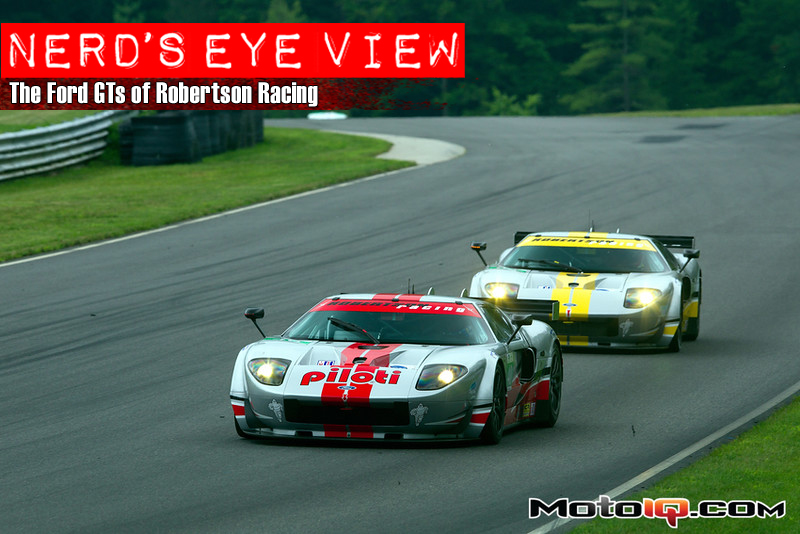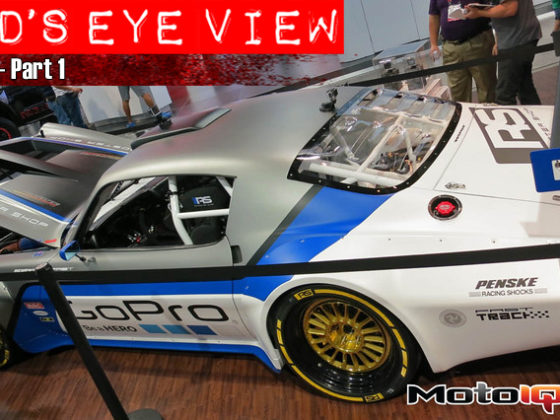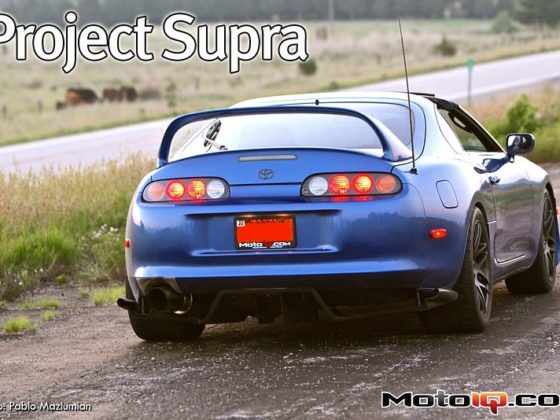,
 Another view of the front brakes, carbon ducts, massive sway bar, and more.
Another view of the front brakes, carbon ducts, massive sway bar, and more. And on to the interior! Are you surprised that there's more carbon? A MoTeC dash helps drivers keep tabs on all of the vital bits, and each car has a slightly different seat – Mr. is super tall with broad shoulders and can't use a seat with a halo, while Mrs. can. Wondering what the kitchen timer is for? HSR/SVRA require a total of 5 minutes worth of pit stop during their events, so this low-tech solution is employed to make sure they don't head back out to the track too soon. On the left you'll note the custom-made padding for the roll cage, complete with zippers for easy removal and replacement. It helps keep the car clean, aids with ingress/egress from the seat, and adds comfort while driving, too. To the right of the safety net is a cooler, which holds ice water for the driver's cool suits. If you haven't seen these before, a small pump in an ice chest pumps cold water through tubes in a shirt. This helps keep the trunk/core of the driver cooler, which helps when the cockpit is over 100°F.
And on to the interior! Are you surprised that there's more carbon? A MoTeC dash helps drivers keep tabs on all of the vital bits, and each car has a slightly different seat – Mr. is super tall with broad shoulders and can't use a seat with a halo, while Mrs. can. Wondering what the kitchen timer is for? HSR/SVRA require a total of 5 minutes worth of pit stop during their events, so this low-tech solution is employed to make sure they don't head back out to the track too soon. On the left you'll note the custom-made padding for the roll cage, complete with zippers for easy removal and replacement. It helps keep the car clean, aids with ingress/egress from the seat, and adds comfort while driving, too. To the right of the safety net is a cooler, which holds ice water for the driver's cool suits. If you haven't seen these before, a small pump in an ice chest pumps cold water through tubes in a shirt. This helps keep the trunk/core of the driver cooler, which helps when the cockpit is over 100°F. Here's another cockpit view, this time in Mrs. Robertson's car. If you're wondering, yes, that is Mr. Bill, and he is secured in place to go along for the ride. You may also notice that the cockpit is slightly different. The halo seat, the cooler, etc. While the couple shares driving duties in some situations, they drive independently in others, and each car is set up according to its primary driver's preferences and driving styles.
Here's another cockpit view, this time in Mrs. Robertson's car. If you're wondering, yes, that is Mr. Bill, and he is secured in place to go along for the ride. You may also notice that the cockpit is slightly different. The halo seat, the cooler, etc. While the couple shares driving duties in some situations, they drive independently in others, and each car is set up according to its primary driver's preferences and driving styles. While this looks like the brains of the operation, it's merely the power distribution module (MoTeC PDM). Think about it like a programmable set of switches and relays, but much fancier. In front is the MoTeC telemetry box. In 2010, ALMS started to allow the use of radio telemetry for certain data parameters. The actual brain in the case of these cars is (out of frame) a Bosch Motorsport 5.0 ECU, tuned by Ed Senf of EMS, Inc. While HSR and SVRA don't require the same level of data management, these cars are still packed full of data logging capabilities.
While this looks like the brains of the operation, it's merely the power distribution module (MoTeC PDM). Think about it like a programmable set of switches and relays, but much fancier. In front is the MoTeC telemetry box. In 2010, ALMS started to allow the use of radio telemetry for certain data parameters. The actual brain in the case of these cars is (out of frame) a Bosch Motorsport 5.0 ECU, tuned by Ed Senf of EMS, Inc. While HSR and SVRA don't require the same level of data management, these cars are still packed full of data logging capabilities.According to H, during their ALMS heyday “everything was logged”. Simple things like acceleration, g-forces and temperatures were a given. But the Robertson Racing team was measuring ride height using infrared sensors, damper travel (“shock pots”), damper load (pressure sensors at the top of the shocks), and even had accelerometers on the suspension uprights themselves. On top of all that, they had multiple air pressure sensors strategically located in the diffusers, under the car, in other locations and more sensors still to evaluate the aerodynamic performance of the car as it went around the track.
 You might be wondering why there is an LCD screen where a rear view mirror should be. Since there is a combination firewall and heat shield separating the cockpit from the engine area, a traditional rear view mirror would show you a blank wall. On the Ford GTs, an off the shelf video camera has its signal inverted and fed to this LCD screen so that the drivers can see what is behind them. More recently, ALMS and the FIA have started to require a much, much fancier system. Bosch and Pratt & Miller worked together to develop a radar-enhanced rear view system that not only shows the view in back but also employs radar to show (via arrows on the screen) what direction the approaching cars are going and color-codes the arrow to indicate closing speed! While it isn't installed on the GTs, this $20,000 system is pretty trick, and more information can be found here or in the video on the next page.
You might be wondering why there is an LCD screen where a rear view mirror should be. Since there is a combination firewall and heat shield separating the cockpit from the engine area, a traditional rear view mirror would show you a blank wall. On the Ford GTs, an off the shelf video camera has its signal inverted and fed to this LCD screen so that the drivers can see what is behind them. More recently, ALMS and the FIA have started to require a much, much fancier system. Bosch and Pratt & Miller worked together to develop a radar-enhanced rear view system that not only shows the view in back but also employs radar to show (via arrows on the screen) what direction the approaching cars are going and color-codes the arrow to indicate closing speed! While it isn't installed on the GTs, this $20,000 system is pretty trick, and more information can be found here or in the video on the next page.



1 comment
Can I purchase the damaged chassis?